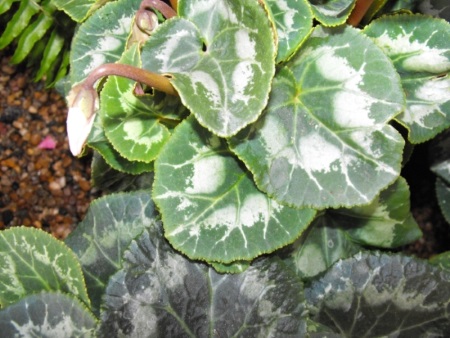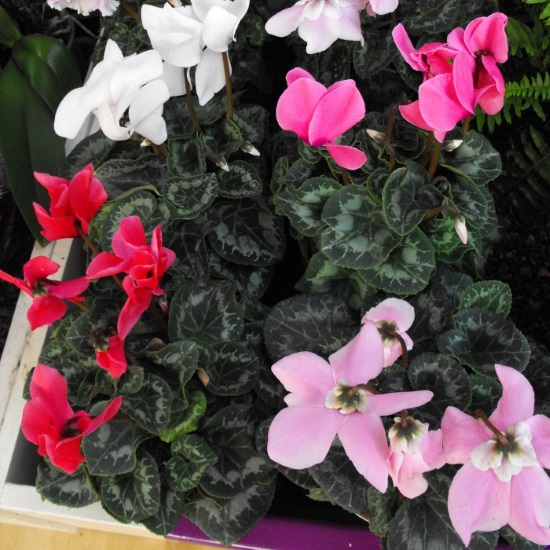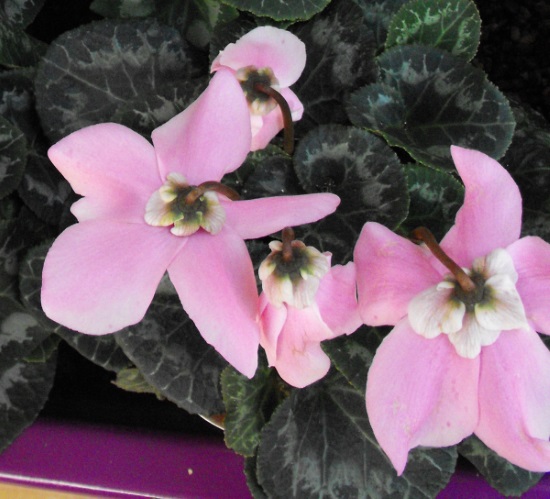





Buying: A quick mention on the buying front. If you are able to buy a plant during fall with some buds unopened your likely to enjoy these delightful plants for longer.

Cyclaman is the common name used for this plant and the name of the genus the persicum variety belongs to. In it's natural habitat you'll find this plant growing within rocky areas, among many shrub vegetation areas and over 1000m above sea levels. It is a tender plant which does not like frost, however, they're grown outdoors (temperate climates) but struggle to survive in winter temperatures.
The genus of cyclames "which are tuber plants" consists of over 20 species and many hybrids, but the persicum and hybrids of this species are the most popular grown indoors. There are also dwarf sizes cultivated (like they are not small enough as they are!), which only grow up to 6 inches tall.
Foliage: The foliage grows very compact and the leaves are patterned and kind of heart shaped, which are very attractive without flowers. The basic leaves are green with silver markings and another has a silver marble effect around most of the leaf and the center is green. The beautiful blooms sit well above the foliage on long stems.
Flowers: The colorful decorative blooms growing on stems sitting above the leaves are available in many colors, including light pink, deep pink, white, red and light pink with the outer edges and bottom of the petals are dark pink in color.
Flowering and Dormancy Period
This plant is named the florist cyclamen because it's widely available at florist's or stores and treated as an annual plant, to be thrown away after flowering. They can be bought during fall and winter with flowers lasting for a few months, with proper care given. It's really a perennial that can flower the following year.
Once the flowers die off and the leaves turn yellow and deteriorate, the plant becomes dormant and wants to rest during the summer period, so if you like "you can have a go at getting the plant to bloom next year." Unlike other plants that grow at their best from spring – fall, the cyclamen does the opposite and grows from the end of fall - spring.
Remove all the dying foliage once much of it has deteriorated and place the plant tuber in a pot with the top section of the tuber sitting above the soil, within a cool environment, without bright light. Stop watering and feeding. You do not want the soil to become wet (wet will rot) and feeding stops because growth has stalled until next year. Once you see the first bit of growth, which should be from September - December, give them a thorough watering and begin normal care.
Level of care: If you grow cyclamens as annual pot plants and discard them after flowering you'll find them easy to care for in cool conditions. Taking care of them during the dormant period to bloom the next season is the tricky part, which is why so many discard them.

Variety of Flower Colors



- Leaves turning yellow: As mentioned above leaves will turn yellow after the flowering season and the crown section will also deteriorate. If the center of the plant (crown) looks fine then your plant may be too warm, have too much direct sunlight, air humidity could be too dry or it could be under-watered.
- Short flower life span: This could be due to dry and warm heat or other reasons, such as not enough water or the plant was bought and bloomed well before you purchased it.
- Leaves soft and drooping and plant soft in center: Your plants in trouble if the crown section in the center is soft, which is caused by over-watering. There is not much you can do to help apart from re-pot and hope for the best, but it will probably die.
Copyright © www.100flowers.win Botanic Garden All Rights Reserved